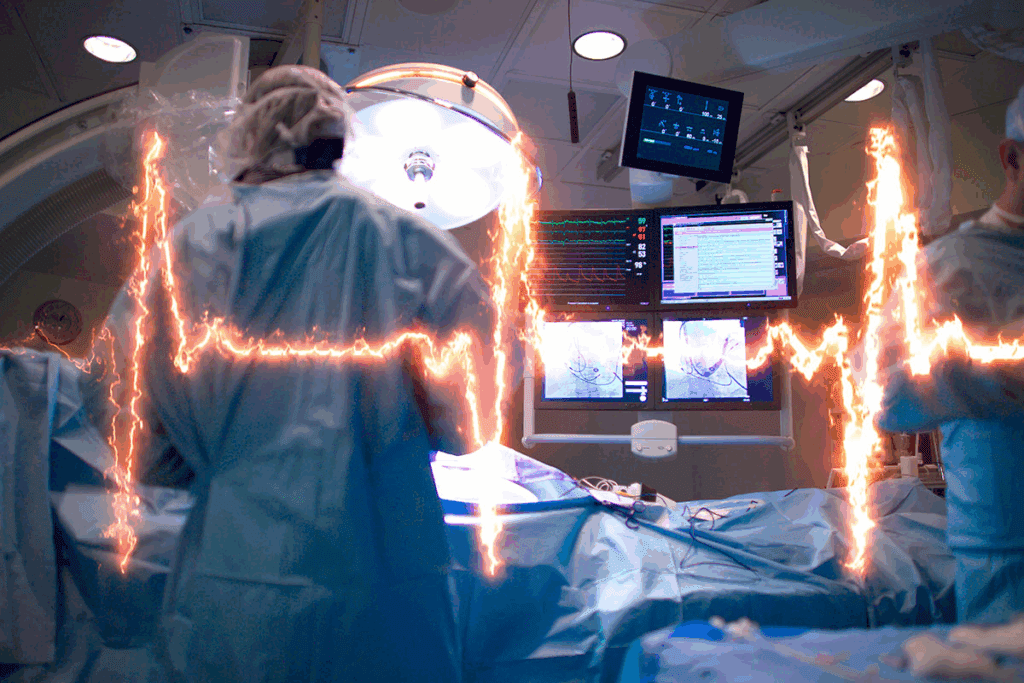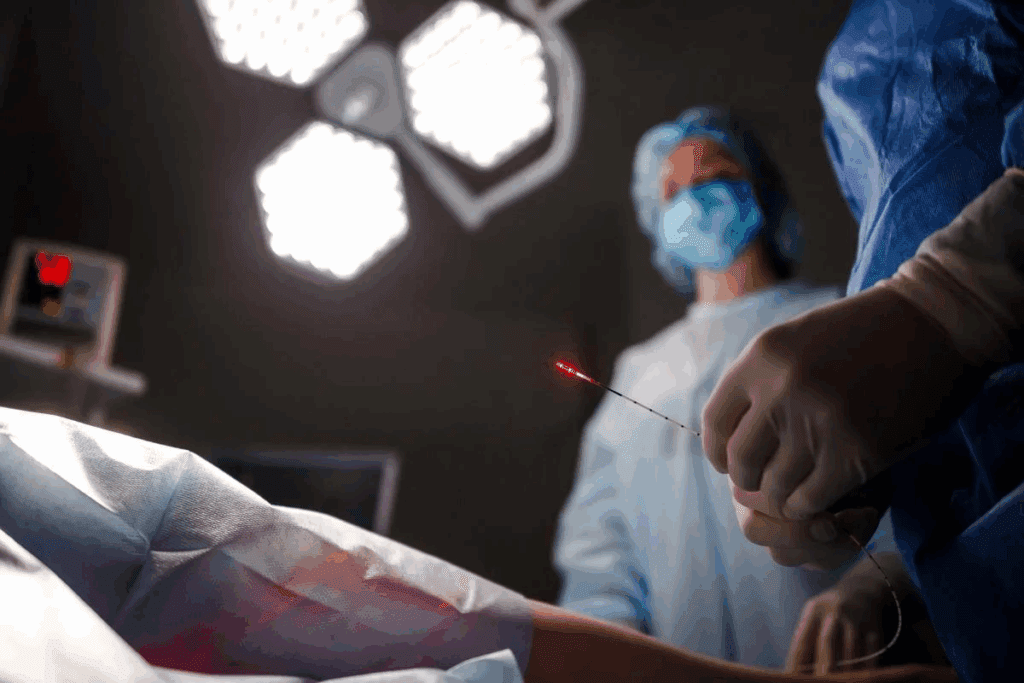Last Updated on November 26, 2025 by Bilal Hasdemir

Bone Marrow Cancer Symptoms: 7 Early Signs of Multiple Myeloma You Should KnowRadio Frequency Ablation (RFA) is a key cancer treatment that uses electrical energy to create heat.radio frequency cancer treatment This heat kills cancer cells. It’s a good choice for those looking for less invasive treatments.
RFA shows how far medical tech has come. It gives hope to those fighting cancer. Knowing about RFA helps patients choose the best treatment for them.
Key Takeaways
- RFA is a minimally invasive procedure using electrical energy to destroy cancer cells.
- It offers a valuable treatment option for patients seeking alternatives to traditional surgery.
- Understanding RFA can help patients make informed decisions about their cancer treatment.
- RFA represents a significant advancement in cancer care, providing new hope for patients.
- Our institution is committed to providing world-class care, including RFA, for cancer patients.
Understanding Radio Frequency Ablation (RFA)

To grasp the importance of Radio Frequency Ablation in cancer treatment, we need to understand what it is and how it works. RFA is a medical procedure that has shown great promise in treating different cancers. It uses electrical energy to create heat, which then kills cancer cells.
Definition and Basic Principles
Radio Frequency Ablation is a minimally invasive method that kills cancer cells with electrical energy and heat. It involves inserting a thin probe into the tumor under imaging. The probe sends out high-frequency electrical currents that heat the tissue, destroying cancer cells.
The procedure is done under local anesthesia, sometimes with sedation to relax the patient. RFA’s precision is a big plus, as it targets tumors without harming much of the healthy tissue around them.
What Does RFA Stand For in Medical Terms
In medical terms, RFA stands for Radio Frequency Ablation. It’s a procedure used to treat various cancers, like liver, lung, and kidney tumors. The term RFA is often used in medical texts and patient care to talk about this treatment.
Knowing what RFA means is key for both patients and healthcare providers. It’s a treatment option that can be very effective for some cancers when other treatments don’t work.
RFA is not just for cancer; it’s also used for chronic pain and some heart conditions. But its impact on cancer treatment is most significant.
| Aspect | Description | Benefit |
| Procedure Type | Minimally Invasive | Less damage to the surrounding tissue |
| Anesthesia Used | Local Anesthesia, sometimes with sedation | Reduces patient discomfort |
| Treatment Target | Tumors and cancer cells | Effective for certain types of cancer |
How Radio Frequency Cancer Treatment Works

RFA uses radio frequency energy to treat different types of cancer. It targets and kills cancer cells while protecting healthy tissue.
The Science Behind Radio Frequency Energy
Radio frequency energy heats up tissue around a tumor. A healthcare professional guides a needle electrode to the tumor area. Then, electrical energy heats the tissue, killing the cancer cells.
This energy turns into heat that spreads through the tissue. This heat damages the cancer cells, killing them.
Thermal Effects on Cancer Cells
RFA’s heat has several effects on cancer cells. It causes:
- Immediate death of cancer cells due to high temperatures.
- Damage to blood vesselscutting off the tumor’s nutrients and oxygen.
- Boosts the immune system’s fight against the tumor.
These effects destroy cancer cells and strengthen the body’s defense against cancer.
In summary, RFA is a strong tool against cancer. It uses radio frequency energy to create thermal effects that kill cancer cells. As we keep improving, RFA’s role in better patient care grows.
Types of Cancers Treatable with RFA
Radio Frequency Ablation (RFA) is a key treatment for many cancers. It’s a less invasive option compared to surgery. We use RFA to treat different tumors, helping patients live better lives.
Liver Cancer Applications
Liver cancer, mainly hepatocellular carcinoma, is a big area for RFA. RFA treats small liver tumors that can’t be removed by surgery. This method kills cancer cells while keeping healthy tissue safe.
Lung Cancer Applications
RFA is also used for lung cancer for those who can’t have surgery. RFA can shrink tumors and ease symptoms like pain and breathing trouble. It’s a way to improve life quality for lung cancer patients.
Cervical Dysplasia and RFA
Cervical dysplasia, a condition before cancer, is treated with RFA. Symptoms like abnormal bleeding, pain during sex, and unusual discharge are common. RFA removes abnormal cells, stopping cervical cancer from developing.
Early detection and treatment of cervical dysplasia are critical. RFA is a safe and effective way to manage it. It lowers the risk of cervical cancer.
The RFA Procedure: What to Expect
Before getting RFA, it’s good to know what happens. The RFA treatment has many steps, from getting ready to getting better.
Pre-Procedure Preparation
Getting ready for RFA is important. Patients might need to stop blood-thinning meds a few days early to avoid bleeding. Also, tests like CT scans or MRI might be done to guide the doctor.
One patient said, “The prep was easy, and the team was very supportive.” This personal care can really help patients feel better about the procedure.
During the Procedure
During RFA, a doctor will put a needle into the tumor under imaging. Imaging tech makes sure the needle is in the right spot, which is key for success.
“The RFA’s precision is a big plus,” said a top oncologist. “It lets us hit the tumor right on, without harming nearby tissue.”
Post-Procedure Recovery
After RFA, you might feel some soreness and bruising where the needle was. These side effects are usually mild and short-lived, going away in a few days.
To help with recovery, you might be told to rest and avoid hard activities for a bit. “Most people can get back to normal in about a week,” a doctor said.
In summary, knowing about the RFA procedure can ease worries and prepare you. By understanding the steps, from start to finish, you can handle your treatment better.
Benefits of Radio Frequency Ablation for Cancer
Radio Frequency Ablation (RFA) is a key treatment for many cancers. It’s known for being effective and less invasive. This makes it a great option for patients.
Minimally Invasive Approach
RFA uses a minimally invasive approach. It only needs small cuts, unlike big surgeries. This leads to less damage and pain for the patient.
This method is safer and better for those who can’t handle big surgeries. It uses imaging to guide a thin probe into the tumor. Then, it sends radiofrequency energy to kill the cancer cells.
Recovery Time and Quality of Life
RFA also helps with recovery time and quality of life. It’s less invasive than surgery, so patients heal faster. This means they can get back to their lives sooner.
Research shows RFA can greatly reduce pain and improve function. It’s very helpful for those with secondary or metastatic spinal cancer. It makes their life better during and after treatment.
RFA’s less invasive nature and quick recovery help patients a lot. It lets them stay independent and keep up with their daily routines. This is key in managing cancer effectively.
Radio Frequency Cancer Treatment Compared to Other Methods
When looking at RFA against surgery, radiation, and chemotherapy, it’s key to understand the differences. We’ll see how RFA compares, focusing on its benefits and drawbacks.
Comparison with Surgery
Surgery and RFA treat cancer, but in different ways. Surgery removes the tumor and some tissue. RFA uses electrical currents to kill cancer cells with heat. RFA is less invasive, leading to fewer complications and a quicker recovery.
But RFA isn’t for all cancers or tumors. It’s best for smaller, accessible tumors. Surgery is better for larger or more complex ones. A Journal of Clinical Oncology study notes, “RFA is often chosen when surgery is not possible or too risky.”
- RFA is less invasive and has fewer side effects than surgery.
- Surgery is more effective for bigger or more complex tumors.
- RFA can be used with surgery to improve results.
Comparison with Radiation Therapy
Radiation therapy kills cancer cells with high-energy rays. RFA uses electrical currents to generate heat. Both can be effective, but they affect the body differently. RFA is great for tumors that don’t respond to radiation.
A study in the International Journal of Radiation Oncology shows RFA can enhance radiation therapy for some cancers. This combo can benefit patients with specific tumor types.
- RFA is effective for tumors resistant to radiation.
- Combining RFA with radiation can improve outcomes.
- RFA has a different side effect profile than radiation therapy.
Comparison with Chemotherapy
Chemotherapy uses drugs to kill cancer cells everywhere. RFA targets specific tumors. RFA is an option for those who can’t handle chemotherapy or have localized cancer.
A Journal of Clinical Oncology review says RFA is valuable for certain cancers, often as part of a treatment plan with chemotherapy. RFA’s localized approach can reduce chemotherapy’s side effects.
- RFA is a localized treatment, unlike systemic chemotherapy.
- RFA is suitable for patients not suited for chemotherapy.
- RFA can be part of a treatment plan with chemotherapy.
Potential Risks and Side Effects
RFA is a top choice for treating many cancers. But it’ss important to know the possible risks and side effects. Like any treatment, RFA can have its own set of issues, from mild to serious.
Common Side Effects
Most people who get RFA face some side effects. These are usually mild and don’t last long. Common ones include:
- Pain or discomfort at the procedure site
- Fever
- Nausea
- Fatigue
Doctors can usually manage these side effects with medicine and rest. Sometimes, side effects can be specific to the area treated. For example, liver cancer treatment might cause temporary liver issues.
Rare but Serious Complications
While rare, there are serious complications to be aware of. These include:
| Complication | Description | Frequency |
| Bleeding | Hemorrhage at the procedure site | Rare |
| Infection | Infection at the site of the ablation | Uncommon |
| Organ Damage | Damage to organs near the treatment site | Very Rare |
A study in the Journal of Vascular and Interventional Radiology shows RFA’s complication rate is low. This highlights its safety.
It’s key for patients to talk about their risks and worries with their doctor. Knowing the possible side effects helps patients make better choices about their treatment.
Effectiveness and Success Rates of Ablation Cancer Treatment
Clinical studies have been key in understanding RFA’s success in cancer treatment. They offer insights into RFA’s effectiveness, helping it find its place in cancer treatment.
Clinical Studies and Evidence
These studies support RFA as a good treatment option for some cancers. It’s effective for early-stage liver and lung cancers, a less invasive option than surgery.
Factors Affecting Treatment Success
Several things can affect RFA’s success. These include the tumor’s size and location, the patient’s health, and the practitioner’s skill. Tumor characteristics like size and blood vessel proximity are also important.
Choosing the right patients for RFA is key. Those with early-stage cancer or small tumors do best. The healthcare provider’s skill is also vital, affecting the treatment’s precision and success.
By understanding these factors and using clinical study evidence, healthcare providers can improve RFA’s effectiveness. This leads to better outcomes for cancer patients.
Candidacy for RFA Treatment
Whether a patient is a good fit for RFA treatment depends on several factors. These include the type and stage of cancer. We look at these factors to see if RFA is the right choice.
Ideal Candidates
Ideal candidates for RFA usually have early-stage cancer or have tried other treatments without success. We check the size, location, and number of tumors..
“RFA is a valuable treatment option for patients with limited tumor burden,” as noted in various clinical studies. It’s great for patients who can’t have surgery because of health issues.
Contraindications
While RFA is a good option, there are some things it’s not good for. These include big coagulation problems, active infections, or tumors too close to important parts. We check these to avoid problems. Patients with pacemakers or other implantable devices need special care, as RFA might affect these devices.
In conclusion, deciding if RFA is right for a patient involves a detailed look at medical criteria and patient conditions. By knowing who’s a good fit and who isn’t, we can give our patients the best care.
Advancements in Radio Waves and Cancer Treatment
The field of cancer treatment is seeing big changes with Radio Frequency Ablation (RFA) technology. RFA is a promising, minimally invasive treatment. It’s getting a lot of research to make it better and safer.
Recent Innovations in RFA Technology
New RFA technology is getting better at precision and results. Advanced imaging techniques help doctors watch the treatment in real-time. This makes sure the cancer cells are destroyed correctly.
New electrode designs are also being made. They help spread the radiofrequency energy better. This leads to better treatment results.
Another big step is using artificial intelligence (AI) in RFA. AI helps plan and do the treatment. It makes the treatment safer and more effective for patients.
Future Directions in Radio Frequency Cancer Cure
RFA is expected to keep getting better. Researchers are working on using RFA for more types of cancer. They’re also looking into combining RFA with other treatments like immunotherapy.
The table below shows some of the key future directions in RFA technology. It talks about how these advancements could help in cancer treatment.
| Future Direction | Potential Impact |
| Integration with AI for personalized treatment plans | Improved accuracy and effectiveness of RFA |
| Development of new electrode designs | Enhanced distribution of radiofrequency energy |
| Combination with immunotherapy | Potential for improved treatment outcomes and reduced recurrence |
As we look ahead, RFA will become even more important in cancer care. By continuing to innovate, we can give patients better, less invasive treatments.
Conclusion: The Future of RFA in Cancer Care
Radio Frequency Ablation (RFA) is a key treatment in cancer care. It’s a minimally invasive way to manage different cancers. RFA helps control tumors, prevent them from coming back, and ease symptoms.
Thanks to new RFA technology, doctors can treat bigger areas. This leads to better results for patients. For example, it’s effective for certain liver cancers, lung tumors, and bone metastasis. To learn more, check out the National Center for Biotechnology Information.
RFA will keep being important in cancer treatment. New technologies and techniques will make it even better. We’re excited for the future of RFA, which will help patients all over the world.
FAQ
What does RFA stand for in medical terms?
RFA stands for Radio Frequency Ablation. It’s a treatment that uses heat to kill cancer cells.
How does Radio Frequency Ablation work?
It uses imaging tests to guide a needle into the tumor. Then, it applies heat to destroy the cancer cells.
What types of cancer can be treated with RFA?
RFA treats many cancers. This includes liver, lung, and cervical dysplasia cancers.
What are the benefits of RFA for cancer treatment?
RFA is less invasive. This can lead to quicker recovery and better outcomes for patients.
How does RFA compare to other cancer treatment methods?
RFA is a less invasive option compared to surgery. It can also be used with other treatments like radiation and chemotherapy.
What are the possible risks and side effects of RFA?
Side effects include pain, fatigue, and swelling. Rare but serious complications include infection, bleeding, and damage to tissues.
Who is a candidate for RFA treatment?
Patients with localized tumors not responding to other treatments are good candidates. Those not suited for surgery also qualify.
What is the success rate of RFA in cancer treatment?
Success rates vary. They depend on cancer type, stage, patient selection, and tumor characteristics.
What advancements are being made in RFA technology?
New RFA technology includes better imaging and more precise energy delivery. These advancements improve RFA’s effectiveness.
What can I expect during the RFA procedure?
Expect preparation, the treatment, and recovery. Medical professionals will guide you through each step.
How does RFA impact recovery time and quality of life?
RFA’s minimally invasive nature can lead to quicker recovery. This improves the quality of life for patients.
References
- Wu, J., et al. (2024). Radiofrequency ablation: mechanisms and clinical applications. MedComm, https://pmc.ncbi.nlm.nih.gov/articles/PMC11445673/






